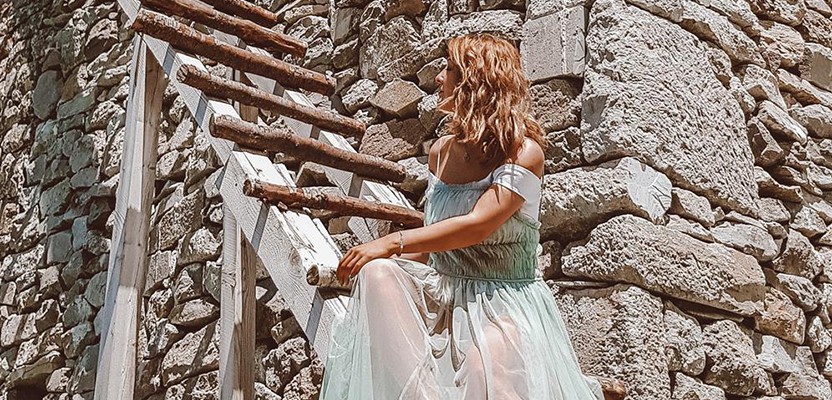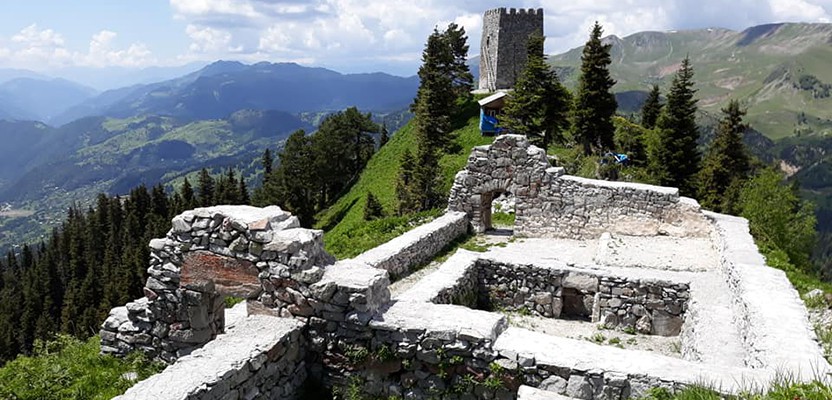
A track in the sky – the way to Khikhani Fortress
Skhalta-Khikhani route is the best destination of mountainous Adjara for the travelers who like hiking and extreme roads. The way to Khikhani Fortress is quite complicated, though it should not worry you. It is about 90 kilometers from Batumi to XII-XIII century Fortress and it is really worth to go all the way. You will discover a real paradise on your way: wooden houses in lush greenery of the mountains, daisy fields, shepherds and narrow paths leading to unknown areas.
This is a two-day route. The first day involves a car trip to your camping place - Khikhadziri village near Khikhani Fortress, where you can spend a night in a tent or a guesthouse. On the second day, you will hike to the fortress, built on a rock, which is 2220 meters above sea level.
While going from Batumi to Khulo by car, we meet Furtio Arch Bridge on the way. There are many such bridges in Adjara. The highway runs south from Furtio to Skhaltistskhali Gorge. 10 kilometers away from Furtio, there is the Skhalta Monastery, the only example of medieval architecture and wall painting in Khulo municipality. Before you reach Furtio Bridge, you can rest by the Furtio spring and have a cup of refreshing coffee, cold drinks or fresh fruits in the nearby café.
Apart from beautiful summer landscapes, while travelling, you will meet local people who, without doubt, will talk to you and ask where you go and what you are going to see. We met a little boy and his grandpa by the Furtio spring. Grandfather examined us carefully and the boy stopped to play ball and agreed to take our picture.
It is 17 kilometers from Skhaltastskhali Gorge to Vardtsikhe turn, where you will find direction signs.
Even though the road to Khikhani Fortress is well-marked, you may need to ask the locals which of the three parts of divided road to take to get to the fortress. They will be happy to explain everything in details.
After Acharistskhali Gorge, as you go up higher in the mountains your ears feel more and more stuffy and your breathing becomes faster. The body slowly gets accustomed to the alpine zone. You will find a cold spring somewhere near there and after a while you’ll start to breathe deeply. This is a different reality, where there are no grey buildings, only greenery surrounds you and some cozy, wooden houses spread here and there. In Bakibako and Khikhani many houses are locked, though looking at the populated homesteads, you can understand that they are inhabited by hard-working people. The red-gloved granny has been looking after bean and cucumber seedlings.
If you reach Khikhadziri village, it means that you have to rest and find a place to stay for a night: it can be a camping place or a guesthouse. I do not suggest to visit Khikhani Fortress as soon as you arrive, because it is a 2-hour walk on a stiff mountain paths that requires energy and good physical training.
You can stay at Yasha Gabaidze’s guesthouse in Khikhadziri. Actually, it is not only a guesthouse. The guesthouse owners have five children and staying at their place you not only enjoy the landscapes and traditional cuisine, but also get acquainted with their lifestyle. The family hotel can host 40-person groups. Apart from the guesthouse, they also have cottages for tourists in the village. The price per night with three meals is 50 GEL, without meals - 15 GEL. For breakfast, dinner and supper you will have ecologically clean, local fruit and vegetables and natural dairy products.
The time itself has stopped at this guesthouse. The owner does not reconstruct the planked house on purpose. The real Adjarian house has to be wooden and breathable. Its atmosphere is simple and moderate, as it has to be in a village house – cozy and calm.

After a good night’s sleep, you can continue your trip to Khikhadziri Fortress. Sport-utility vehicle will take you to the forest, the rest of the way you’ll have to walk. According to our step-counter, to get there and back you have to walk 18 000 steps. It is about 6 kilometers: 3,50 kilometer walk in the forest and 2, 50 km- on a stiff path, which leads to the fortress.

If you have a sun hat and water, you can securely continue your way. You slowly step up the footpaths along the twisting slopes and observe the beautiful landscapes of the Skhaltistskhali Gorge. The main thing is not to hurry, often have a rest, so you don’t miss anything.
The rocks are covered with the bright green alpine flowers. The scent of Rhododendron and Azalea fills the air. You take a deep breath, feel a little woozy and go on your way.
Nobody knows the real date of Khikhani Fortress construction. Most scientist believe that it is X-XIII centuries. According to the local legend, the fortress construction is attributed to Queen Tamar.
The Khikhani Fortress was a main residence of feudal lords – the Abuselidzes. Later it was occupied by Ottoman Turks. In 1815, Khikhani Fortress was a fortified place, where the rebel against Ottomans - Selim Khimshiashvili was defending himself until he was captured and beheaded. The oldest, narrow, tiring path is the only approach to the castle.
At the end of the path the steeples of Khikhani Fortress and its large complex emerge. Now only ruins are left from that formerly inaccessible construction.

You will definitely get tired, start to complain and even think that you waste your time coming here, but at the end of the route, your fatigue will go away and you will have only happy memories about your two-day active leisure and obsessive ideas about the future summer days: “What is going to be next?”





